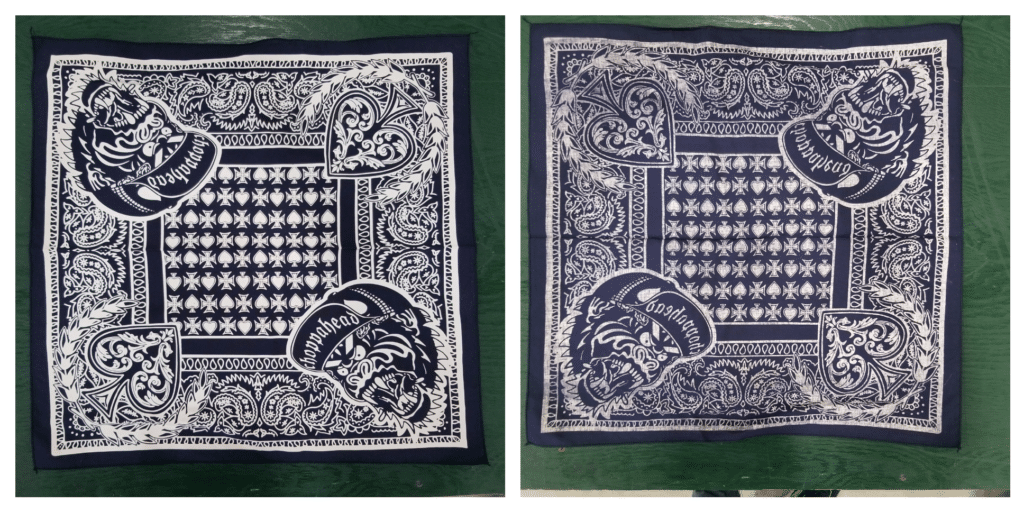
Our Inks Soak Thru The Bandana
Front Of Bandana |
Back Of Bandana |
One of the top three questions that we regularly get asked is if we print on both sides of the bandanas that we produce. The short answer is that we do not. I will explain further …
Reason #1 – Why We Don’t Print On Both Sides Of A Bandana
One of the reasons why we get asked this question is because there are some bandana providers that use a method of printing called “digital fabric printing“. This method of printing uses white fabric and CMYK color processing to create a virtually unlimited color spectrum option. This is a high speed process and is done on a roll to roll digital printing machine that requires white fabric to be used for every print.
There are a few notable drawbacks to using this process, primarily the minimum order being very large and secondarily, that the back of the bandanas that are printed using this method, are left completely white. If you order a red bandana with black print using digital fabric printing, one side of the bandana is printed completely red with the black design being added. While you may have a beautiful print on one side, the back is left white. Most bandana buyers don’t like the fact that the back is white.
Reason #2 – Why We Don’t Print On Both Sides Of A Bandana
Providers that do offer printing on both sides of bandanas do so with two main compromises in quality. The first is that they use non-water-based inks. Plastisol is a plastic based, heavy ink. It is commonly used in the United States for T-Shirt printing and not used by most of the rest of the world. Plastisol is in effect … liquid plastic. While this is a durable material and one that doesn’t soak through fabric, the drawback is that it is heavy, scratchy and not environmentally friendly. This “may” not matter when used on the outside of a t-shirt, but it sure does matter when it’s put on a product that touches your face, neck or head.
Providers can “get away with” printing on both sides of a bandana when using plastisol because it sits on top of the fabric vs. soaking into it. There is little risk of soaking through when printing with plastic. But, as noted before, it sits on top of the fabric, and in addition to the issues already mentioned, it’s prone to cracking over time.
One of the second compromises that other providers seek when printing on both sides of a bandana is to use ultra thick bandanas, double layered fabrics sewn together or heavy fabric. This type of bandana prevents soaking through but also adds weight and inflexible, making the final “bandana” more like a linen napkin than something you would want to wear on your body.
Reason #3 – Why We Don’t Print On Both Sides Of A Bandana
The PRIMARY Reason For Why We Don’t Print On Both Sides Of A Bandana
The ink soaks through! Our bandanas are manufactured by us and are made from the traditional fabrics and designs of the classic American bandana. As a result, when printing with water based dyes and inks, the design soaks completely through the bandana to the back. You may have seen from spilling water on yourself, it soaks through your garments readily. This also occurs when we print your bandana fabric. Soaking through gives the mirror image of what is printed on the front. If you look at most retail store bandanas, this type of printing is what you’ll see, which is why retail bandanas are not printed on both sides either. Soak through is as desirable effect. It helps keep the bandana light weight and flexible as well as comfortable to the wearer.
As you’ll not from the image above, even though we don’t technically print on both sides of the bandana, due to the “soak thru” the effect and impact is that both sides of the bandana are indeed decorated with a design.
It’s important to note that the soak through is not a controllable factor in any customer bandana printing job. It will occur, but not with consistent results.
If you have additional questions regarding this topic, please consider giving us a call (908) 806-8337 or email us.